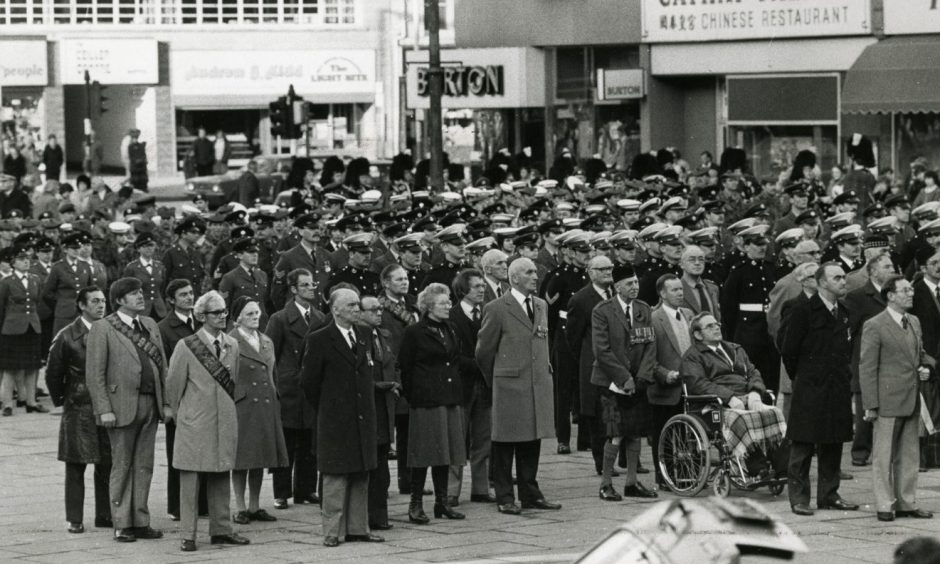
These photographs from the DC Thomson archives show how Dundee has remembered the sacrifices made in times of war since the 1920s.
War veterans, schoolchildren, members of all races and religions have stood side by side through the decades to honour those from the city who never came home.
The First World War brought deep sorrow to Dundee, which suffered a heavy toll and by the time the guns fell silent over 4,000 men had made the ultimate sacrifice.
It was meant to be the war that ended all wars.
It wasn’t.
Armistice Day and Remembrance Sunday events in Dundee honour victims not just of the First World War and the Second World War, but more recent conflicts in Bosnia, Afghanistan and Iraq.
1929
Thousands turned out in the rain and gathered in front of The Pillars in Dundee on Monday November 11 1929 to pay an impressive tribute to the fallen.
Buglers recruited by the British Legion were also based on Dundee Law, Hilltown, Stobswell, Sinderins and Lochee High Street during the weekend of remembrance.
1930
The 12th Armistice Day event in the city prompted another great gathering with singing during the service led by members of the Dundee Amateur Operatic Society.
The Evening Telegraph said the Poppy Day appeal in 1930 saw a “splendid army of collectors” being enlisted and they made a “thorough canvass of the city”.
1933
The 1933 Armistice Service in Dundee was held on the steps of the Caird Hall, where the commencement of a two-minute silence was heralded by the firing of the old-time gun.
Traffic was forbidden in the city centre for 35 minutes during the service.
1961
For nearly 100 years the Scottish Poppy Appeal has raised millions of pounds to support the needs of veterans and their families living in Scotland.
The Remembrance Day symbolism of the poppy started with a poem written by a brigade surgeon who was struck by the sight of the red flowers growing on a ravaged battlefield during the First World War.
1979
A war memorial has stood on Dundee Law since 1925, a silent totem to love and loss gently watching over the coastal community below.
Initial designs weren’t big enough or grand enough, but the eventual winner was one that would be visible from all parts of Dundee.
It was to have a square base and octagonal tower, a circular crown and a brazier on top for a beacon.
1981
A Remembrance Day service taking place aboard HMS Camperdown in 1981.
HMS Camperdown (RNR) was a Royal Naval Reserve training centre in Dundee supporting Tay Division between October 21 1970 and May 31 1994.
1981
The Battle of Loos exacted such a toll that the 4th battalion Black Watch, known locally as “Dundee’s Own” was effectively merged with 5th Battalion.
In a moving tribute to the fallen of both world wars, the beacon on top of the Law hill remains lit on September 25 of every year in rightful recognition that their sacrifice hasn’t been forgotten.
1982
Parents, friends and onlookers thronged by the railings as the High School of Dundee Combined Cadet Force band played at the annual Remembrance Day service in 1982.
Due to the wet weather, however, pupils were kept indoors.
1983
Veterans of the First World War and Second World War marching along Reform Street from the City Square in November 1983, before taking the salute from the Lord Provost.
A lot of men who came back never spoke about it. It is difficult to comprehend what some of these men would have seen on a day-to-day basis on the battlefield.
1984
Lord Provost Tom Mitchell about to lay a wreath on Dundee Law in 1984.
The parade assembled under a heavy grey sky to observe two minutes of silence.
1987
The Dundee Police War Memorial, located at the junction of West Marketgait and West Bell Street, between the city’s police HQ and sheriff court buildings, commemorates dozens of soldiers who died in conflict – as well as PC Robert Stirrat, deemed a casualty of the war despite never having joined the military or leaving Dundee.
He was on duty in Broughty Ferry when he was called to investigate a report of an “unfamiliar object” on the beach close to Fisher Street and Dundas Street.
He realised it was a mine, which exploded as he tried to secure it to prevent it drifting back to sea.
The blast was said to have been so powerful it blew out the windows of nearby buildings.
1989
Standing out in all weathers is not everyone’s idea of how to spend their day.
These unsung heroes of the buttonhole brigade were selling poppies outside the City Churches in 1989, where every penny donated goes to the Royal British Legion.
Proof that not all heroes wear capes.
- These images from Remembrance Day events in bygone days appear courtesy of The Dundonian, which appears in the Evening Telegraph every Wednesday.






















Conversation